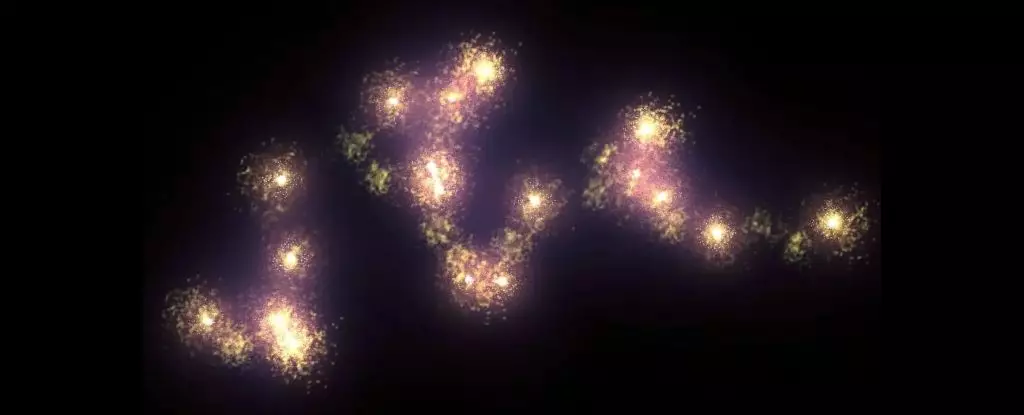The cosmos never ceases to amaze, and recent revelations about the Hercules-Corona Borealis Great Wall underscore the enormity and complexity of our universe. Initially estimated at a jaw-dropping length of 10 billion light-years, this gargantuan cluster of galaxies is now believed to extend up to 15 billion light-years. This astonishing scale not only provides an opportunity to marvel but also poses a profound challenge to current cosmological paradigms, forcing a significant reassessment of our understanding of cosmic evolution and structure.
Astronomers have long sought to penetrate the mysteries of the universe, and the emergence of gamma-ray bursts—powerful explosions resulting from cataclysmic astrophysical events—has opened new windows into its fabric. These bursts serve as luminous beacons, illuminating the dark reaches of space and offering critical insights into the distribution of galaxies. Each mighty explosion provides a framework for mapping out previously undiscovered cosmic structures, making the Great Wall’s study a seminal endeavor in cosmology.
The Quest for Cosmic Truth Through Gamma-Ray Bursts
The Great Wall was initially identified in 2014 by a team led by István Horváth, Jon Hakkila, and Zsolt Bagoly, who analyzed a cluster of gamma-ray bursts. Their seminal work revealed a surprising concentration of bursts that deviated from the expected distribution, raising the possibility of this vast cosmic structure. Following this, a more comprehensive analysis has now revisited the data, encompassing an extensive sample of 542 gamma-ray bursts with known redshifts. This enhanced scrutiny confirmed the structure’s staggering dimensions, shifting its status from theoretical curiosity to a convincing reality.
The significance of redshift in this context cannot be overstated. By measuring the extent to which the light from these gamma-ray bursts has been stretched due to the universe’s expansion, researchers can accurately gauge the distances involved. This method allows for an unprecedented understanding of the scale and reach of the Hercules-Corona Borealis Great Wall, delivering dramatic implications for cosmic structure and evolution theories.
Challenging Established Cosmological Principles
These developments pose a significant challenge to the cosmological principle, which asserts that the universe is homogeneous and isotropic on a large scale. According to this principle, massive structures should be distributed uniformly; deviations might suggest deep-rooted flaws in our theoretical frameworks. The existence of the Great Wall, now apparently more substantial than previously believed, raises questions about this fundamental principle and suggests that the universe may contain surprises and inconsistencies we have yet to comprehend fully.
Previously identified massive structures, such as the Quipu and Sloan Great Wall, ranged from 1 to 1.37 billion light-years across. The Clowes-Campusano galaxy group and the Giant Arc further pushed the boundaries but still fell short of the newly confirmed size of the Great Wall. Each new discovery has unveiled a layer of complexity that complicates our conventional models of the cosmos, undermining the idea of a smoothly uniform universe.
The Great Wall push—a structure larger than 1.2 billion light-years—is now not only a possibility but a confirmed reality, marking a significant departure from the established narrative of cosmic uniformity. This underlines the critical need for ongoing research and deeper investigations into the clustering of galaxies, guiding us toward a more nuanced understanding of universal dynamics.
Peering Into the Unknown
Despite the new data, questions persist regarding what these findings imply about the universe’s history and evolution. The origins and implications of such extraordinary structures remain poorly understood, underscoring the intriguing paradox of modern cosmology. For every answer presented, more questions spring forth, illustrating the complexities of a universe filled with dark matter, dark energy, and enigmatic phenomena that continue to baffle scientists.
As researchers dive deeper into this cosmic enigma, they will undoubtedly unearth additional mysteries that challenge our comprehension of reality. The Hercules-Corona Borealis Great Wall stands as a bold testament to the infinite nature of investigative science, revealing just how much we have yet to learn about the universe. There exists an ever-expanding realm of knowledge just waiting to be uncovered, beckoning us to press forward in our quest for understanding the cosmos, one discovery at a time.
In a world where each cosmic revelation leads to wonderment, the Great Wall’s broader implications beckon to curious minds, urging them to explore further into the magnificent depths of the universe. In our grasp and just beyond it, limitless knowledge awaits, daring us to extend our reach into the unknown.


Leave a Reply